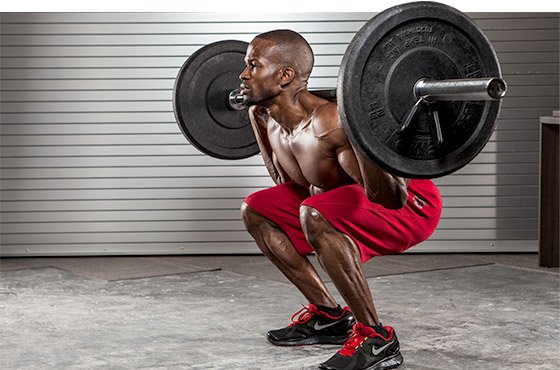It seems everything around us is designed to make our lives easier. For example, when was the last time you went to the library to research anything? With Google, all you have to do is type in a few letters—"Do I even lift, bro?"—and you're subjected to an infinite variety of results and insults. Thousands of people will line up to let you know that no, you most definitely do not lift. Easy peasy!
The gym is one of the only places where we purposely try to make things more difficult. We add more weight to the bar and perform more reps for the sole purpose of doing more work, and we're (hopefully) rewarded with a lean, muscular, athletic-looking body.
I've already outlined two of my favorite ways to get trainees moving more weight in big lifts in "Keep the Weights Moving Up!" Now we're going to look at some other ways to make your squats in particular more difficult. Use these as a really sucky vacation from your traditional back squats or front squats, and you'll find you're magically stronger when you return.
1. Paused Squats
If you watch Olympic weightlifters train and compete, you'll notice how explosive they are out of the hole when they squat. This is because they're taking advantage of what's called the "stretch-shortening cycle," which is a smarty-pants way of referring to the elastic power of our muscles when they're stretched.
One way for us non-Olympians to make squats more challenging—and to help develop more starting strength out of the hole—is to go out of our way to omit the stretch-shortening cycle by implementing a purposeful pause.
To perform paused squats, simply camp out for a spell once you hit depth. This breaks the eccentric-concentric chain, but it's important that you remember not to break something else: tension. For safety and performance, stay tight during your pause. Don't relax! Then explode out of the hole like you normally would.
I like to increase pauses progressively, like any other variable. Often, I'll use a setup like this:
- Week 1: 1-second pause
- Week 2: 3-second pause
- Week 3: 5-second pause
After sticking with these for a few weeks, you should have a better starting strength, and perhaps more muscle as well. After all, the pause helps to increase time under tension, which is an important component of muscle growth.
2. Anderson Squats
Taking the paused squat concept a step further, one of my favorite squat variations is the dead-start squat, also known as the Anderson squat, named after the legendary 20th-century strongman Paul Anderson. Instead of starting in the standing position you'll start—and end—in the bottom position.
Again, this is a fantastic way to help develop starting strength and learn to maintain bodily tension in the bottom position. And as a bonus for the masochists out there, Anderson squats just make you hate life altogether.
Begin by setting the safety pins at a height where you start, just below parallel. Get underneath it, and work yourself up to full tension by bracing your abs and setting your lats. Pull down on the bar, explode off the pins and finish at the top with your glutes. Descend back down to the pins and come to a complete stop.
3. 1½ Squats
These are another fantastic way to increase time under tension&mdasn;an aspect of muscle growth which gets overlooked too often. The concept is simple: Unrack the barbell, squat down to the bottom position, and come back up halfway. Descend back down into the bottom position, then return back to the full standing position. That's one rep.
A word of caution: These are brutal! You may want to plan on taking the escalator the next day.
The Elephant Squatting in the Room
As a strength coach, and as someone who often coaches athletes to squat every day, I'd be remiss if I didn't state the obvious: Squatting to depth is the easiest way to make squats more challenging!
I'm not impressed with guys who brag about quarter-squats. Sure, you could argue that there's a time and place for such a thing, but that argument is weak sauce. When lifters start loading more and more weight at the expense of range of motion, they quickly reach a point of diminishing returns.
Neglecting to squat to below parallel—where the anterior (front) of the thigh goes below knee level—cheats you out of a lot of potential muscle growth in the lower body, particularly in the hamstrings and gluteal muscles. It also eliminates many of the benefits squatting can provide to help offset the postural dysfunction we accumulate on a daily basis from sitting so much.
If I just hit a sore spot, consider spending some quality time with the box squat, which I discuss in "Squat Like a Boss." Box squats are an excellent way to not only groove a proper squat pattern. They also keep you honest and teach you what it's like to squat to a passable depth.

Neglecting to squat to below parallel cheats you out of a lot of potential muscle growth in the lower body, particularly in the hamstrings and gluteal muscles.
Start Where You're At, Know Where You're At
You're going to see a drastic decrease in the amount of weight you can handle in any of the variations here—including box squats—but that's OK. Embracing difficulty demands that you check your ego at the door.
Take solace in knowing that while the load decreases, you're also increasing the distance the bar is moving, the time you're spending under tension, or both. Suffice it to say, you're still doing plenty of work.
When you first start tinkering with advanced variations like these, keeping records might be the furthest thing from your mind. Shouting obscenities at an inanimate piece of metal might seem like a higher priority.
Make record-keeping a priority, though. No matter the variation you do, competing against your training log and trying to increase the weight on the bar over time is a fail-proof way to make these squats—and everything else you do—more challenging. Keep good records, review them, and beat them!

